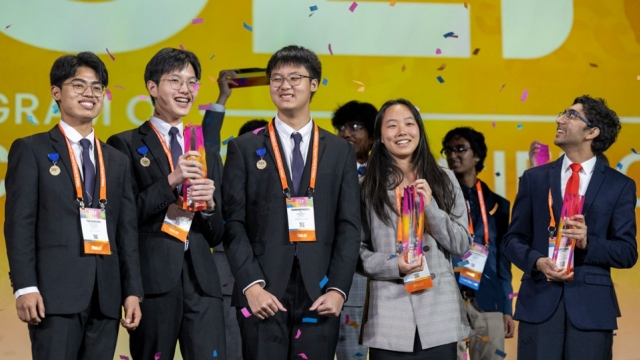Laptops, lanyards and poster boards — so many poster boards. The Regeneron International Science and Engineering Fair, or ISEF, is the largest high school STEM competition in the world. And the winners of this year's competition, held in Dallas, have been announced.
• Kaitlyn Wang won first place and a $75,000 prize for finding an efficient way to identify certain exoplanets that orbit very closely around their stars.
• Saathvik Kannan received one of two Regeneron Young Scientist Awards and a $50,000 prize for using biocomputational methods to understand the causes of heightened infectivity in the disease mpox after it reemerged in 2022.
• Teepakorn Keawumdee, Pannathorn Siri and Poon Trakultangmun received the second Regeneron Young Scientist Award of $50,000 for developing an innovative incubation chamber that promotes the survival of the green lacewing insect, a natural predator of the mealybug, a harmful pest.
Maya Ajmera is the president and CEO of Society for Science and the executive publisher of its award-winning magazine, Science News. Ajmera told Scripps News, "We [had] over 1,600 finalists, half of them young women, who [came] from over 60 countries, regions and territories, as well as every state in the United States."
Students competed for nearly $9 million in scholarships.
"They [were] coming in with original scientific engineering projects that are really looking at areas of artificial intelligence. They're looking at areas of cancer treatment, they're looking at areas of climate change," Ajmera said.
Through the halls of the convention center, students were explaining, testing and presenting their hard work to judges from all over the country.
SEE MORE: Bright young minds work to solve big problems at science competition
"These young people are doers," Ajmera continued. "They're not reading a biology textbook or an engineering textbook — they're actually looking at a problem, for many of them, that affects them or their communities. And once they find that problem, then they can become problem solvers."
One of those problems that received attention from several students at ISEF is school shootings.
"I've seen the emotional toll that it's taken in my community," ISEF finalist Ava Cotroneo said. "My mom's a first-grade teacher, and she does active shooter drills with her children all the time."
Ava tested her prototype bulletproof backpack insert with AR-15 rifles and worked with a local Navy base to get the materials she used. "Students come up and tell me their experience with gun violence," she added. "I've had multiple threats at my school … I feel like the best we can do is adapt with the times, so that's kind of what I'm trying to do right now."
Maya Shah was another ISEF finalist. She's from a suburb of Dallas that's just a short drive from the Allen outlet mall where there was a deadly shooting a few weeks ago — something she says has become normalized.
"The fact that we have lockdown drills in schools, where the lights are turned off, and the teacher tells us what would happen if a gunman were to come in — that's a scary reality. It's almost dystopic," Shah said.
SEE MORE: Here's how you can watch the 95th Scripps National Spelling Bee
Shah's project focused on determining the character traits and behaviors common in would-be school shooters. She says she wants to stop these kinds of shootings before they happen.
"It becomes something that people talk about, but nothing is done," she said. "So, the biggest thing about my solution is it's not costly. It's not hard to implement. All it needs is the time to try to persuade these people."
While this was Maya's first time at the ISEF competition, it's not nearly her first successful science project.
She told Scripps News, "I had a project about COVID and masking. And I ended up actually getting that published in a peer-reviewed medical journal."
Society for Science held its first science fairs in the 1950s and since then has launched almost 400 science fairs in more than 60 countries.
"This is a very kumbaya moment for us," Ajmera said. "These are future collaborators, business partners, and they're going to make lifelong friends, and that is very powerful for us. I don't know about you, but they give me a lot of hope for the future."
Trending stories at Scrippsnews.com



